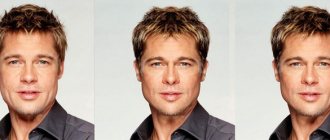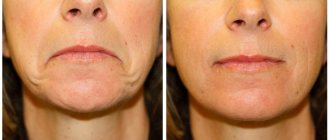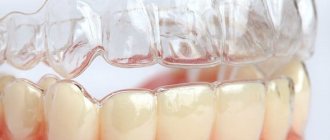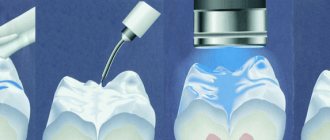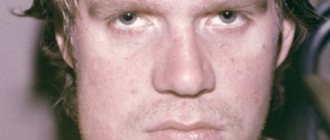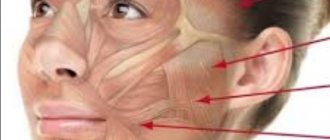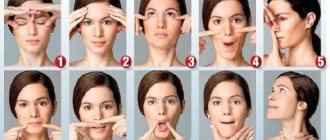What is distal bite
Dentists call the distal bite prognathic.
This disease refers to an abnormality of the dental jaw. It is one of the most common, found on both baby teeth and permanent teeth. From a visual point of view, a distal bite is an obvious protrusion of the upper jaw over the lower jaw. The structure of the teeth is disrupted, which creates an unaesthetic appearance.
Symptoms
Characteristic profile in distal occlusion
Oral disease can be identified by characteristic manifestations :
- Run your fingertip along the teeth. If there is a feeling that the lower jaw is moved back and the front jaw is sticking out, this means that there is a prognathic bite.
- When connecting the top and bottom rows, a small gap is formed. Or it will become noticeable that the teeth are directed inward.
- The upper jaw bone looks larger and more powerful than the lower one.
A person can see all of the above signs on his own. However, there are also those that only a specialist can identify. If you take an X-ray of the jawbone, the image will show that the lateral teeth are narrowed, and the upper row is presented in the shape of a fan.
Orthodontist about distal occlusion:
External signs
Even an acquaintance will be able to determine by facial signs that his interlocutor has such a diagnosis. A person with a distal bite will be given:
- Convex face shape.
- Mouth slightly open.
- The lips look uneven, as if one lip is protruding over the other.
- Strongly pronounced crease in the chin area.
Some changes in a person’s behavior may also appear: his speech becomes incomprehensible, chewing, breathing and swallowing reflexes are disrupted.
Classification
According to the clinical manifestations of narrowing of the jaw arch, the anomaly is divided into several forms, each of which has its own characteristics :
- Narrowing of the jaw along its entire length . It is characterized by an elongated anterior section towards the frontal region. In this case, the teeth have a fan-shaped position. The lateral incisors fit tightly to the central ones.
- Tight jaw. The main sign of the anomaly is a saddle-shaped shape and compression of the dentition in the area of premolars and molars.
The compression in this case is uneven and does not extend to other parts of the jaw.In addition to narrowing, the pathology of this form is manifested by a violation of the direction of growth of the lateral teeth, which begin to protrude towards the cheeks or tongue.
- Narrowing of the anterior section . With this anomaly, the dentition of the frontal area has a V-shape. The incisors protruding forward form an acute angle and are tightly arranged.
- Trapezoidal shape . The jaw arch has four corners and its appearance resembles a trapezoid. The incisors are very crowded, but do not protrude forward. Their rotation around their axis is often noted.
- Uneven development . It is characterized by a narrowing of the jaw arch in certain areas. It differs from other pathologies by the manifestation of crowding only in certain segments.
This is interesting: Dental veneers - what are they: advantages, disadvantages, cost
Regardless of the form of the anomaly, their clinical picture can worsen over time, leading to even greater deviation of the teeth and narrowing of the jaw arches.
Reasons for development
There are several facts that influence the development of malocclusion.
| Types of anomaly | Peculiarities |
| Congenital | Causes:
Consequences of the described reasons:
|
| Acquired | Causes:
Consequences of the described reasons:
|
What could be the consequences?
The sooner a patient turns to a specialist with a similar problem, the more chances he will have to hope for a positive result and correct the pathology. It is very important to follow the recommendations and carry out comprehensive treatment.
If the patient does not pay attention to his health in a timely manner, he may develop a number of problems :
- Change in chewing reflex. During food processing, not all teeth will “work” fully, and the load will no longer be uniform.
- Each time, the geometry of the face will become more deformed. Of course, few people will like such a visual defect.
- According to statistics, people with a similar symptom are 3-4 times more likely to suffer from caries or periodontitis.
- The higher the degree of the disease, the more difficult it is to treat. Often, doctors cannot fully provide prosthetics to patients with an overly convex bite.
Reference! This disease is not dangerous. You can live with it fully for many years without feeling discomfort, but still at the risk of changing the functioning of the dental system.
Kinds
Distal bite is a pathological phenomenon of the jaw bone. Pathologies are divided into several subclasses.
- According to the location of the front teeth:
- Horizontal;
- Vertical.
- According to the degree of development of the anomaly:
- First form;
- Second form.
- Due to appearance:
- Skeletal;
- Dental.
- Distal occlusion.
- Deep bite.
Brief description of subclasses:
| Name | Characteristics |
| Horizontal | The upper teeth are directed towards the upper lip. |
| Vertical | The upper incisors rest against the lower gum and injure it. |
| First form | The lateral teeth move slightly towards the inside. The structure of the upper composition takes the form of a fan. |
| Second form | The palatal slope begins to shift upward. There is no intermediate gap during the connection, since the upper teeth are directed towards the lower teeth and connect with them. |
| Skeletal | Is a consequence of jaw abnormality |
| Dental | Is a consequence of dental pathology |
| Distal occlusion | Characterized by uneven closure of teeth. The edge of the upper teeth is retracted into the cusp of the lower teeth. |
| Deep bite | The most serious and dangerous stage. The upper or lower incisors rest against the gums, injuring them. |
Consequences for bone structures
Reduction in the width and height of the supporting bone.
The alveolar bone of the jaw remodels depending on the forces applied to it. Whenever the function of a bone undergoes modification, significant changes occur in its internal architecture and external configuration. Bone needs stimulation to maintain its shape and density. The tooth is necessary for the development of alveolar bone, and it requires stimulation to maintain its density and volume.
When a tooth is lost, insufficient bone stimulation causes a decrease in bone density in the area with loss of width (and then height) of the bone. During the first year after tooth loss, bone width decreases by 25%, and the total height loss in the first year after tooth extraction for emergency prosthetics is more than 4 mm.
When teeth are completely missing, a removable denture does not stimulate or support the bone: it accelerates the loss of bone volume. The load from chewing is transferred only to the surface of the bone. As a result, blood supply is reduced and there is an overall decrease in bone volume.
This problem is of paramount importance, but in the past it has tended to be recognized but ignored by conventional dentistry.
Tooth loss causes remodeling and resorption of the surrounding alveolar bone and ultimately leads to atrophy of the edentulous ridges. Although the patient is often unaware of the possible consequences, they become apparent over time.
Initially, loss of bone volume leads to a decrease in bone width. The remaining narrow ridge often causes discomfort when the thin overlying tissues begin to experience stress from the soft tissue-supported denture.
The process is further accelerated if the patient wears a poorly fitting soft tissue-supported prosthesis, but patients generally do not realize this. As a rule, patients neglect regular examinations of the condition of their teeth and come to the doctor only after several years, when the artificial teeth are worn out or cannot be tolerated any longer.
Patients who wear dentures 24/7, which is about 80%, expose hard and soft tissue to greater forces, which can accelerate bone volume loss.
Increased risk of mandibular fracture due to significant loss of bone volume.
Loss of bone volume in the upper or lower jaw is not limited to the alveolar bone. Parts of the main bone of the lower jaw can also be subject to resorption (resorption, thinning), especially in its posterior parts, where severe resorption can lead to the loss of 80% of its volume. In this case, the body of the lower jaw has an increased risk of fracture even under the action of low-impact forces.
Other possible problems associated with thinning bone and partial or complete missing teeth include:
- Protrusion of mylohyoid and internal oblique ridges with increasing pressure sores;
- Protrusion of the anterior mental tubercles, bedsores and increased mobility of the prosthesis;
- Incorrect muscle attachment - near the top of the ridge;
- Vertical displacement of the prosthesis during contraction of the mylohyoid and buccal muscles;
- Shift of the prosthesis forward due to rotation of the lower jaw;
- Increased sensitivity when brushing teeth due to thinning of the mucosa;
- Increased mobility of the prosthesis and functional bedsores.
Diagnostic features
A patient who suspects he has a diagnostic malocclusion requires:
- Visit an orthodontist immediately. He will be able to visually determine whether there is pathology and what stage it is.
- Undergo a clinical examination, identifying the size, shape and structure of the teeth.
- If necessary, perform teleradiography to identify the structure of the bite.
- Examine the functionality of important parts of the oral cavity: masticatory muscles and temporomandibular joints.
The specialist will make a model of the jaw and study all the diagnostic results. Based on them, he will be able to decide on the treatment method.
Video on the topic:
Jaw displacement and facial asymmetry: how to fix it at home
A normal person's face cannot be completely symmetrical. The difference between the left and right sides is practically unnoticeable. You can identify small differences if you look closely at a photograph or carefully study a person.
But in some cases, asymmetry is pathological in nature and this is the reason for contacting a specialist. In most cases, a clear violation of facial proportions is associated with jaw asymmetry. Let's talk about it in more detail.
Description of facial asymmetry
Normally, imbalances in proportions do not exceed 2-3 millimeters. The left side of the face is characterized by femininity and smoothness of features.
They are slightly elongated in the vertical plane.
The right side is slightly wider, more defined and sharp. But there are also pronounced facial asymmetries associated with profound disorders.
It is not difficult to distinguish physiological deviations from pathologically disturbed proportions. To do this, just look in the mirror. The deformity is expressed in a skewed chin, noticeable displacement of the corners of the mouth, one cheekbone higher than the other.
Jaw displacement is not only a problem of aesthetics, the bite is also disturbed, bruxitis may begin to develop, which as a result is fraught with large inconveniences and expenses during treatment.
Find out what to do if your jaw is jammed on one side.
Symptoms of deformation of the jaw, chin, cheekbones
Facial asymmetry has manifestations. Based on these symptoms, a diagnosis can be made:
- sagging cheeks due to weakness of facial wrinkles;
- the affected part of the face takes on the appearance of a mask, the corner of the lips moves down;
- smoothing natural frontal and nasolabial folds;
- the pained expression of the asymmetrical half;
- obvious violation of facial expressions (difficulty closing an eye, lifting a lip or wrinkling a forehead);
- widening of the palpebral fissure.
In complex cases with damage to the facial nerve, symptoms intensify.
Sometimes the signs are accompanied by pain.
If muscle function deteriorates significantly and affects the side of the neck, the patient develops a pathological tilt of the head. Gradually, one cheek sags, and the sore side of the face smoothes out. Often there are problems with nutrition, and pain manifests itself precisely during chewing food. This material will tell you why teeth go numb.
Causes
There are several factors for the occurrence of facial asymmetry. These may include physiological and pathological disorders. The development of incorrect facial proportions is based on cosmetic, neurological, dermatological and dental problems.
Congenital facial defects leading to asymmetry are quite rare.
Usually, deviations are detected already in the prenatal period, when the fetus is actively developing. Sometimes such disorders are accompanied by various syndromes.
There is also senile facial asymmetry. This is due to age-related changes against the background of developing muscle weakness.
Varieties of curvature
The following changes are observed: a crooked mouth, chin, cheekbones, and a skewed jaw to one side.
Congenital and acquired
Congenital:
- abnormal structure of the cranial bones;
- underdevelopment of the lower jaw;
- developmental disorder of the temporomandibular joint;
- improper formation of the neck muscles;
- damage to connective tissues and the muscular system.
Purchased:
- injuries to the face, jaws, facial bones;
- inflammation or pinching of the facial nerve;
- malocclusion;
- complete secondary and primary adentia (absence of teeth);
- strabismus;
- soft tissue atrophy due to systemic diseases;
- torticollis in children.
Physiological reasons
These factors include bad habits. Incorrect posture with a characteristic tilt of the head to the side for a long time leads to facial asymmetry. The face can change if you constantly chew gum on one side of the jaw or squint your eyes.
If a person sleeps on one side for a long time, this leads to facial distortion.
Pathological:
- neuropathic defects of the facial nerve, Bell's palsy;
- facial contracture after paralysis with increased tone on the healthy side of the face;
- synkinesis (involuntary movements of the muscles of the face or eyes);
- dyskinesia of facial muscles;
- pain syndromes on one side of the face;
- myasthenic syndrome accompanied by asymmetry.
Treatment
In most cases, surgery is used to correct asymmetry. Thanks to facial plastic surgery, it is possible to achieve significant alignment of facial proportions.
Types of operations
- Thread lifting. Polydioxanone threads are injected subcutaneously and dissolve on their own.
Gradually, collagen fibers form in their place. Plastic surgery is suitable for patients with physiological asymmetry caused by age-related changes in the facial contour. The procedure lasts 30-60 minutes, the average duration of the effect is 2 years. - Contour plastic. The cosmetic method involves the use of injections or implants.
Thanks to the operation, you can achieve maximum face lifting and eliminate visible asymmetry. Contour plastic surgery has many contraindications, which are voiced by a specialist. - Blepharoplasty .
Used to correct the skin fold above the eye. With the help of eyelid surgery, pronounced asymmetry of the eyes is eliminated. Additionally, blepharoplasty makes it possible to get rid of swelling under the eyes. If the patient has synkinesis associated with neurological abnormalities, eyelid surgery may not be effective. - Browlift. Browplasty is used to move an asymmetrical eyebrow to a higher position. This method is often used if implants alone are not enough or correction of the forehead is required.
- Rhinoplasty. Used to correct the nose after various injuries. The operation lasts no more than 1.5 hours.
Find out about digital orthopantomography of teeth by clicking on this link.
Massages
If asymmetry is not associated with complex injuries and damage to the facial nerve, you can correct your face with the help of massages.
Unfortunately, this is difficult to do at home.
Only a specialist knows the massage lines and is able to restore the contours of the cheeks and other areas of the face. Finger and palm exposure is effective in case of long-term use. It will take 10 to 20 sessions to achieve the effect.
Possible complications: malocclusion, nervous tics
Uncorrected asymmetry or complete lack of treatment can have consequences. This applies to both the physiological and psychological sides:
- twitching of facial muscles;
- involuntary nervous tic of the eyes and other parts;
- increased risk of soft tissue inflammation;
- chronic headaches;
- high blood pressure;
- stress on the jaws and neck.
Often, against the background of incorrect facial proportions, the patient experiences psychological instability. In the social sphere such a person may feel depressed.
To maintain proportions after surgery, you must adhere to the recommendations of the plastic surgeon.
about how to correct facial misalignment
This video will tell you in detail how to correct facial asymmetry.
Conclusion
- Jaw asymmetry is a complex, but still treatable disease.
- In most cases, the defect is eliminated through surgery.
Depending on the nature of the curvature, rhinoplasty, thread lifting, contour plastic surgery, etc. can be performed. - If the asymmetry is not pathological in nature, then it can be reduced through massages.
- After therapy, it is recommended to do facial exercises and follow the doctor’s recommendations.
Find out about the symptoms of a dislocated lower jaw here.
Source: https://ZubZdorov.online/bolezni/zubov/anomalii/asimmetriya-chelyusti.html
Features of the fix
The treatment process for adults and children may differ.
In children
Patients under 13 years of age have a greater chance of achieving a positive treatment result. The jawbone is plastic and easier to mechanically influence.
| Fixed structures (plates) | Removable systems (trainer and myobrace) |
Advantages:
| Advantages:
|
Flaws:
| Flaws:
|
Prerequisite: it is necessary to wean children from bad habits (putting toys, fingers, etc. in their mouths). Otherwise, the treatment will be ineffective.
Gymnastic exercises play an important role in the treatment of children: opening the mouth, closing the mouth, sticking out the tongue, closing the lips and moving the gums from side to side.
In adults
| Removable structures (plates and systems). Main material – ceramics, metal | Correction of teeth with specialized devices (Herbst, Sabbach spring) |
Advantages:
| Advantages:
|
Flaws:
| Flaws:
|
Adult patients should keep in mind that correcting a bite is a lengthy procedure. The treatment process usually lasts more than three years. Rehabilitation lasts more than one year - fixing the teeth in the achieved position.
Dentist about the treatment of distal bite:
Correction Methods
Earlier, it was already said about the most common methods for treating children and adults. It is worth talking separately about the mechanism of action of all possible treatment options:
- Braces . The design fits tightly to the teeth. Provides acceleration of the development of the upper jaw and slows down the growth of the lower jaw. In systems for children, the mechanism of action is the same as that of conventional plates. A distinctive feature is that they are made of medical silicone. Braces for adults are made of ceramic or metal
- Orthodontic devices . The orthodontist will reduce its length by pulling teeth from the upper row. This will allow you to have an even bite.
- Facial bow . This concept refers to a special device that is attached to the outside of the face. It exerts a pressing effect, which forces the teeth to “stand” in place. The patient must wear such a facial corset during the day - up to three hours, as well as during sleep.
- Intermaxillary traction . They are used only for those people who need to straighten their front jaw forward. The design is created individually after an impression is made by the orthodontist. You need to wear it constantly. The general course of treatment is 3-4 months. At the discretion of the specialist, the procedure may consist of several stages.
- Surgical intervention . It is required only if the disease is advanced and treatment by other means is impossible. Orthodontists and dentists come to such a decision in rare cases. After surgery, the patient undergoes a long rehabilitation process.
Braces
Orthodontic apparatus
Facebow
Intermaxillary traction
A clear example of correcting a distal bite:
How the treatment method is selected
The result directly depends on the correct treatment. The specialist must consider several important points when choosing a method :
- First of all, the age of the patient is very important. For children under 13 years of age, surgical operations are performed only in extreme cases when there is a direct threat to their health. In other situations, as a rule, treatment is carried out only with safe braces.
- The higher the degree of pathology, the more serious treatment is required. If there is no discomfort for the patient, and nothing interferes with his full functioning, then special designs can be used. They are created only according to individual layouts. If the shape of the face is severely distorted, chewing, respiratory and speech functions are impaired, and dental incisors injure the gums, then surgical intervention will be required.
- High blood pressure, high body temperature, poor health, pregnancy and lactation, any viral or chronic disease - all this can become a contraindication for treatment.
- The intervention technique differs depending on which bite needs to be worked on. For example, only intermaxillary traction will allow the front jaw to move forward. If it is not possible to achieve the desired effect with its help, then additional measures are taken in the form of wearing a Herbst apparatus. Two spring models are attached behind the back canine; they additionally fix the dentition and direct it to the desired position.
- Removing protruding teeth is much easier. The most effective methods are braces for children or surgery for adults.
Important! Before starting treatment, be sure to take a responsible approach to choosing a clinic and specialist.
Treatment
Treatment of narrowing of the dentition is carried out only for certain indications and using special devices.
Before correction, the doctor prepares the dentition, which includes removing or treating bad teeth, replacing old low-quality fillings with new ones, and professional oral hygiene.
Once the cause of the pathology is identified, work is carried out to eliminate it.
Expansion devices
Treatment methods are prescribed depending on the shape and location of the anomaly.
Most often, during therapeutic treatment I use the following devices :
- Derichsweiler apparatus. Refers to non-removable screw structures. Designed for correction of the upper jaw, which is narrowed along its entire length, in particularly difficult cases.
This design is used mainly in children in the late period of a mixed dentition or with a permanent one formed. The device has a strong effect on bone tissue.The device is a metal two-part base of a beam type, which is fixed on the supporting teeth. The base is connected using a special spacer screw, which moves the two parts of the base apart during adjustment.
Restoration of the normal size of the jaw is achieved by gradually breaking the palatal suture. Thanks to this, with the help of a screw device, the apical base is expanded in the sagittal and transverse directions, covering the area of the nasal septum.
The use of this design, in some cases, allows one to avoid surgical intervention. But since the device is a rather aggressive technique, it is used quite rarely.
- Expansion plates equipped with springs and expansion mechanism. They are a more gentle option and are used to correct the jaw during the period of milk or early replacement teeth.
This device consists of a base that exactly follows the arc of the sky. The device has a built-in small mechanism that allows for minor correction of the jaw shape.The plate is attached to the supporting teeth using metal clasps, which allows it to be removed at any time.
Wearing this device allows you to correct the shape of the jaw arch by expanding the palatal suture and directly transforming the bone tissue in the area of the alveolar bone, due to the tight fit of the base of the plate.
This is interesting: Crooked teeth - why pathology develops and whether it can be corrected
These devices are capable of restoring the normal shape of the jaw arch only in childhood. Surgical methods are most often used to treat adults.
Derichsweiler apparatus
A non-removable screw device is a two-part base (usually metal) with rings, which is fixed to the supporting teeth. The base is connected using a special screw.
It is used to adjust the size of the upper jaw (i.e., when it is compressed along its entire length), or to correct particularly severe cases of occlusion. This device is mainly used to treat children with a mixed dentition or adolescents with a mature permanent dentition.
The restoration of the jaw size to normal parameters occurs with the gradual opening of the palatal suture. As a result, with the help of a screw mechanism, the width of the apical base increases in the transverse and sagittal projection with the obligatory coverage of the area of the nasal septum.
Over time, the resulting gap is filled with bone tissue, thereby increasing the size of the jaw.
Important! The use of this device allows in most situations to avoid surgery, but its aggressive effect on tissue prevents the active use of the device.
The following indicators are considered to be the advantages of the Derichsweiler apparatus:
- the defect is corrected smoothly;
- the child cannot remove the structure from his mouth on his own;
- the device does not injure soft tissues;
- tooth roots remain in place (do not move).
The disadvantages of correcting anomalies with this device are:
- during the adaptation period, increased salivation is observed;
- hygiene procedures become more difficult;
- it is impossible to independently activate or adjust the position of the device, which is why you need to visit a doctor frequently;
- high price.
The video presents the operating principle of the Derichsweiler apparatus.
Expansion plates
This is more gentle than the previous method of correcting the anomaly. The design is designed to expand the jaw in the primary or early mixed dentition.
The basis of the device is a base that exactly repeats the palatal arch. It has a built-in mechanism (an orthodontic screw and a stainless steel spring), with the help of which the jaw parameters are corrected.
Fixation in the oral cavity is accomplished through crowns placed on the posterior molars or with clasps and a vestibular arch (in a removable version).
Wearing a plate allows you to correct the defect by expanding the palatal suture and rearranging the bone in the alveolar area.
Important! This orthodontic device is capable of restoring the parameters of the jaw arch exclusively in childhood (the period from 5 to 12 years).
Pros of using an expansion plate:
- painless process;
- simultaneously with the expansion of the jaw, the frontal elements are aligned;
- Removal for hygiene procedures is allowed.
Minuses:
- Suitable for children only;
- discomfort may arise from the bulk of the structure.
Palatal expander
This is a complicated version of the Derichsweier apparatus. From the central sliding part there are 4 arches with rings that are attached to the back molars. The design has proven to be very effective in treating children: a child’s jaw enlarges in about three weeks. Adults will need more time, up to one and a half years.
As the name suggests, a palatal expander can only expand the upper jaw. To expand the lower jaw, you will have to select a different design. Sometimes this device is confused with a palatal clasp, which has a completely different function: it serves to fix molars during bite correction. Often it plays the role of an auxiliary structure, for example, used with braces.
Pros of a palatal expander:
- speed of formation of the correct bite;
- painlessness;
- possibility of self-activation.
Cons of a palatal expander:
- tongue injury;
- complicated oral hygiene.
Systems required for mandibular distraction
If there are problems with the lower jaw, completely different devices are usually installed - distractors. In this case, adult patients need to dissect the lower jaw with an ultrasonic scalpel before installing the structure.
There are different types of distractors. This variety allows you to choose a design even for infants, because pathologies of the lower jaw are most often congenital, and they need to be corrected as early as possible.
The distractor is based on a flat body on which a self-locking screw and slider are located. This system is complemented by levers with wedge-shaped ends for fixation in the tissues of the alveolar ridge.
Surgical intervention
The operation is used in particularly difficult cases when purely orthodontic and myofunctional treatment is ineffective. Surgery can be used as the only treatment and used in combination with orthodontic correction.
Orthodontic surgical treatment involves a three-stage procedure. First, orthodontic preparation of the rows for surgery is carried out, then surgical intervention follows, and the treatment ends with orthodontic correction again.
Basic surgical operations in the treatment of narrowing of the jaws:
- Removal of a tooth/teeth to provide space for expansion surgery. Most often, premolars are removed - one on each side.
- Perforation of the jaw bone . It is carried out with detachment of the mucous flap. Through holes are made in the skeletonized bone at some distance from each other, and they are connected by grooves. The surgical wound is sutured and an orthodontic expansion device is installed.
This is interesting: Subtleties of splint therapy in dentistry - price, essence of the technique
Perforation is necessary to initiate the process of osteogenesis (formation of new bone in the area of the holes) and facilitate expansion. Two processes - row expansion and osteogenesis - occur in parallel.
Sequence
The procedure for surgical expansion of the dental arch takes place in several stages :
- Setting up anesthesia. As a rule, the operation is performed only under general anesthesia, as it involves deep trauma to the tissues of the oral cavity.
- Using an ultrasonic scalpel, an incision is made into the mucous membrane and periosteum. Depending on the type of anomaly, an incision can be made on one or both sides of the jaw.
- The soft tissue flaps are peeled away, exposing the cortical plate of the jaw. Then, by perforation, certain segments are dissected.
- An expanding apparatus is installed in the area of dissection.
- The mucosal flap is returned to its place and sutured.
The correction procedure begins only 3 days after the operation.
The primary activation is carried out by a doctor, and then the patient carries out it independently at home. Activation is completely painless and does not cause any difficulties.
Course duration
The period of exposure using surgical techniques may vary depending on the age of the patient and the severity of the anomaly.
On average, the treatment period, from surgical intervention to final tissue healing, is about 1 month.
Then hardware treatment is prescribed, which corrects the development of the row and restores the normal position of the teeth.
Therapy with devices lasts from 1 to 6 months.
In conclusion, to consolidate the result obtained, it is necessary to undergo a retention course, the duration of which is 3–8 months.
The total treatment time on average will be 11–12 months.
Repeated treatment (is it possible to narrow the jaw if the treatment was incorrect)
Given the fashion for widening the jaw, for a supposedly beautiful smile, one should expect a request for the reverse movement of teeth. If you carry out orthodontic movements not because it is necessary for medical reasons, but because “this way I will be more beautiful,” naturally, orthodontists will have more problems. People tend to make mistakes, and therefore expectations from expansion are not always justified. But is it possible to return everything back? Sometimes it’s possible, and sometimes it’s not. Each case should be examined individually.
This is the case our specialists had to face.
The photo shows a crossbite. In the lateral areas, the upper teeth excessively predominate over the lower teeth - a lingual crossbite.
This situation is a consequence of a medical error - excessive expansion of the upper jaw. Our task was to normalize the width of the dentition.
In each case, the orthodontist makes the choice of a treatment device. He has to evaluate all the features of the patient’s clinical history and the structural features of the dental system.
We treated this patient with a brace system.
Of course, during such treatment it is necessary not only to narrow the jaw, but to solve all the problems of orthodontic treatment.
Photos BEFORE and AFTER treatment of crossbite.
Smile BEFORE and AFTER
Prevention
It is impossible to guarantee the prevention of the development of distal occlusion. But there are several preventive measures that can reduce the risk of its progression:
- From the very moment of birth, you should monitor the condition of the baby’s oral cavity. If there are people in the family with a similar diagnosis, then it is necessary to do strengthening gymnastic exercises.
- You should not allow your child to frequently suck a pacifier, put a finger in his mouth, taste toys, or eat solid food.
- It is recommended not to breastfeed your baby for too long.
- It is important to monitor the content of vitamins in the baby’s body.
There are a huge number of people in the world who share similar problems, including diseases. Therefore, it is very important to pay attention to the reviews left under the article by patients who have already been able to overcome a similar illness.
The patient tells her story of treatment for distal occlusion:
How missing teeth affect your health and appearance
Every person cares about his appearance and does not want to lose his youth and attractiveness in the eyes of others. To do this, we play sports, use cosmetics and anti-aging products, and use the services of plastic surgery.
Many branches of medicine, including dentistry, are aimed at maintaining an attractive appearance. Did you know that premature tooth loss affects the number of folds and wrinkles, leading to disruption of the symmetry and harmony of your face.
In a word, having healthy and beautiful teeth is no less important for preserving youth than, for example, perfectly smooth skin or harmony and beautiful relief of the muscles of the body. Bad teeth and missing teeth can cause many problems.
Almost all of us have encountered the problem of caries and tooth decay. The first thing that comes to your mind is the desire to restore them. You visit dentists, evaluate possible options for tooth restoration, but over time, you get used to the current situation and the desire to solve this problem gradually disappears until complications arise.
I don’t have a tooth, I’ll just walk like this for now...
Everyone knows that there are no unnecessary parts in our body and the loss of any organ or part of it entails consequences. In such a situation, your body is reconstructed and adjacent or functionally similar organs compensate for its absence.
Same with teeth. In the absence of even one tooth, the functional load is redistributed to the remaining teeth, which ultimately bear an increased load.
The teeth of different groups are responsible for different functional components of the seemingly simple function of chewing food.
For example, the front teeth are designed for biting off food, the lateral teeth are for grinding and forming a bolus of food, giving it the desired consistency. The teeth of the lateral group maintain the height of the bite, and therefore form the symmetry of the horizontal thirds of the face. Fangs usually form correct facial features (for example, the oval of the face) and influence the smoothness and trajectory of movements of the lower jaw when chewing food.
Remember the famous American actress Marilyn Monroe. Everyone knows not only her bright acting image, but also the very characteristic oval of her face, namely the recession of her cheeks, associated with the absence of 6 upper molars. This example clearly demonstrates how the absence of just two teeth affects external facial features.
Tooth loss and the aging process
As mentioned earlier, even the absence of one tooth affects the age of our body: wrinkles begin to form, the skin becomes less elastic. The skin becomes pale and the lower third of the face becomes haggard. How does this happen? Let's try to understand the mechanisms behind these signs of aging.
So, when a tooth is removed, atrophy of the jaw bone tissue occurs, leading to its thinning. Due to the lack of function, a change in trophism (nutrition) in the jaw bone invariably occurs. This manifests itself in a decrease in the number of blood vessels in the area of removal and weakening of the bone structure.
This weakening can cause teeth to move toward the defect, resulting in malocclusion.
Incorrect tooth alignment can lead to disruption of the tone of the chewing muscles, forming wrinkles. At the same time, the cheeks fall inward, which affects the oval of the face. In the absence of front teeth, the lips begin to sag, and the nasolabial fold becomes more pronounced, the corners of the mouth droop, which visually makes us older. All this leads to asymmetry, loss of muscle tone and signs of aging.
How else does missing teeth affect our body?
In the photo: changes in the oval of the face due to atrophy of the bone tissue of the jaw
Missing teeth affects not only beauty, but also functionality. One of the important functions of teeth is the function of chewing food.
Poor chewing of food can provoke various health problems throughout the gastrointestinal tract, because improperly processed food makes it difficult to digest. Inadequate digestion leads to poor absorption of the nutrients, vitamins and microelements necessary for our body.
Of course, this affects our immunity and leads to a huge number of diseases.
Missing teeth: consequences for the body
The next segment that can be considered is the condition of the oral cavity and the entire body.
What else does missing teeth affect?
The most obvious and immediately noticeable to others, besides aesthetic shortcomings, is a speech disorder. This is due to incorrect articulation when pronouncing certain sounds.
The impact of bad teeth on our self-esteem and, recently, often on our career.
Remember the saying “You meet someone by their clothes...” Would you yourself hire an employee who has a repulsive appearance? Well, you yourself know what consequences the absence or aesthetic defects of teeth have for your personal life.
What to do if you have no teeth or your smile is far from perfect
It is very important to solve dental problems in a timely manner and not to delay prosthetics, to prevent the occurrence of dental deformations and bone atrophy.
Immediately after tooth extraction using implantation, it can be equally replaced within a few days.
As an alternative to implantation, you can choose bridges, however, it should be remembered that the use of bridges over time leads to overload of the teeth. If an increased load falls on a diseased tooth, this leads to premature loosening and loss of teeth.
A removable denture aggravates the atrophy of the jaw bone tissue, which complicates future implantation. Such dentures, along with being hygienic, have one significant drawback - the need to grind the teeth under a crown with a lock, onto which the removable structure will be fixed.
Dental implantation will help you avoid all these problems. This is one of the best means of combating bone atrophy. We offer a full range of dental implantation services including:
Complex dental implantation allows you to restore even complete loss of teeth in just 7 days.
Express dental implantation is a technique that allows you to replace one to several teeth immediately after removal.
Classical dental implantation is a planned implantation technique with delayed prosthetics; you can get a guaranteed and predictable treatment result with an installment plan of up to 6 months, which cannot but please patients.
Which implantation method is right for you?
Sign up for a free consultation now. Our specialists will offer you options for dental prosthetics and draw up a clear and detailed treatment plan. For your convenience, online registration is available 24 hours a day.

